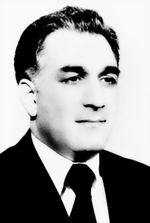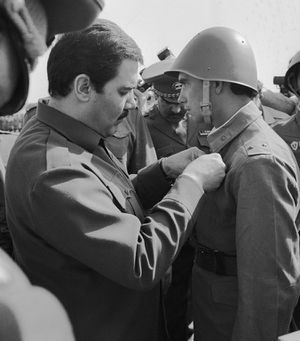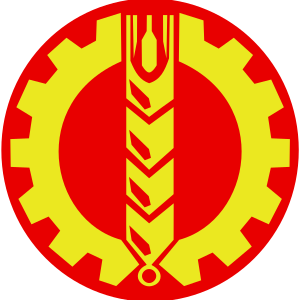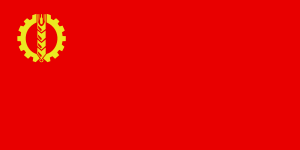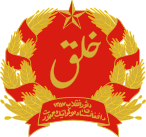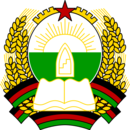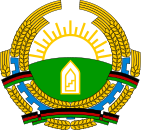جمهورية أفغانستان الديمقراطية
| 1978–1992 | |||||||||
النشيد: ملي سرود "النشيد الوطني" | |||||||||
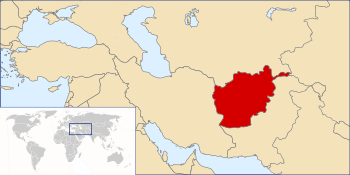 | |||||||||
| العاصمة | كابول | ||||||||
| اللغات المشتركة | داري پشتو | ||||||||
| الحكومة | جمهورية اشتراكية (1978–1990) جمهورية إسلامية (1990–1992) انظر النظام السياسي أدناه | ||||||||
| الأمين العام | |||||||||
• 1978–1979 | نور محمد تراقي (الأول) | ||||||||
• 1986–1992 | محمد نجيب الله (الأخير) | ||||||||
| رأس الدولة | |||||||||
• 1978–1979 | نور محمد تراقي (الأول) | ||||||||
• 1992 | عبد الرحيم هاتف (الأخير) | ||||||||
| رأس الحكومة | |||||||||
• 1978–1979 | نور محمد تراقي (الأول) | ||||||||
• 1990–1992 | فضل الحق خالقيار (الأخير) | ||||||||
| التشريع | المجلس الثوري | ||||||||
| الحقبة التاريخية | الحرب الباردة | ||||||||
• ثورة ثور | 27–28 أبريل 1978 | ||||||||
• تأسيس الحكومة | 30 أبريل 1978 | ||||||||
| 28 أبريل 1992 | |||||||||
| المساحة | |||||||||
| 1992 | 647،500 km2 (250،000 sq mi) | ||||||||
| التعداد | |||||||||
• 1992 | 13811900 | ||||||||
| العملة | أفغاني (AFA) | ||||||||
| |||||||||
جمهورية أفغانستان الديمقراطية (Dari: جمهوری دمکراتی افغانستان؛ Pashto: دافغانستان دمکراتی جمهوریت؛ إنگليزية: Democratic Republic of Afghanistan؛ DRA)؛ تغير اسمها في 1987 إلى جمهورية أفغانستان (Dari: جمهوری افغانستان؛ Pashto: د افغانستان جمهوریت؛ إنگليزية: Republic of Afghanistan)، تواجدت من 1978 حتى 1992 وغطت فترة حكم الحزب الديمقراطي الشعبي الأفغاني (PDPA) الاشتراكي لأفغانستان. أتى الحزب للسلطة بانقلاب عُرف بإسم ثورة ثور، التي أطاحت بحكومة محمد داوود خان. خلـَف داوود نور محمد تراقي رئيساً للدولة والحكومة في 30 أبريل 1978. تراقي و حفيظ الله أمين، منظم ثورة ثور أدخلا العديد من الإصلاحات المثيرة للجدل أثناء حكمهما، أبرزها مساواة حقوق المرأة بالرجل، والتعليم الشامل والإصلاح الزراعي. وما أن استوليا على الحكم حتى نشب صراع على السلطة بين أنصار حزب خلق بقيادة تراقي وأمين وأنصار حزب پرچم بقيادة ببرك كارمل. فاز أنصار خلق وطـُهـِّر الحزب من أنصار پرچم. أبرز زعماء پرچم نـُفـوا إلى الكتلة الشرقية والاتحاد السوڤيتي.
بعد صراع خلق-پرچم، a power struggle within the Khalq faction began between Taraki and Amin. Amin won the struggle, and Taraki was killed on his orders. His rule proved unpopular within his own country (due to the reforms mentioned earlier)، وفي الاتحاد السوڤيتي. تدخل الاتحاد السوڤيتي، supported by the Afghan government, in December 1979, and on 27 December Amin was assassinated by Soviet military forces. Karmal became the leader of Afghanistan in his place. The Karmal era, lasting from 1979 to 1986, is best known for the Soviet war effort in Afghanistan. The war resulted in large numbers of civilian casualties, as well as millions of refugees who fled into Pakistan and Iran. The Fundamental Principles, a constitution, was introduced by the government in April 1980, and several non-PDPA members were allowed into government as part of the government's policy of broadening its support base. Karmal's policies failed to bring peace to the war-ravaged country, and in 1986 he was succeeded as PDPA General Secretary by محمد نجيب الله.
Najibullah pursued a policy of National Reconciliation with the opposition, a new Afghan constitution was introduced in 1987 and democratic elections were held in 1988 (which were boycotted by the mujahideen). After the Soviet withdrawal from Afghanistan, the government faced increasing resistance. 1990 proved to be a year of change in Afghan politics: a new constitution was introduced, which stated that Afghanistan was an Islamic republic, and the PDPA was transformed into the Watan Party, which has survived to this day as the Democratic Watan Party. On the military front, the government proved capable of defeating the armed opposition in open battle, as in the معركة جلال أباد. However, with an aggressive armed opposition, internal difficulties, a failed coup attempt by the Khalq faction in 1990 and the فض الاتحاد السوڤيتي، the Najibullah government collapsed in April 1992.
التاريخ
ثورة ثور وتراقي: 1978–1979
محمد داوود خان، رئيس جمهورية أفغانستان من 1973 حتى 1978، أطيح به أثناء ثورة ثور (ثورة أبريل) إثر وفاة مير أكبر خيبر، a Parchamite politician from the People's Democratic Party of Afghanistan (PDPA) who died under mysterious circumstances.[1] حفيظ الله أمين, a Khalq, was the coup's chief architect.[2] نور محمد تراقي، the leader of the Khalqists, was elected Chairman of the Presidium of the المجلس الثوري, Chairman of the Council of Ministers and retained his post as General Secretary of the PDPA Central Committee.[3] وتحته كان ببرك كارمل، the leader of the Parcham faction, as Deputy Chairman of the Revolutionary Council[4] and Deputy Chairman of the Council of Ministers, Amin as Council of Ministers deputy chairman[5] and Minister of Foreign Affairs[3] and Mohammad Aslam Watanjar as Council of Ministers deputy chairman.[6] The appointment of Karmal, Amin and Watanjar as Council of Ministers deputy chairmen proved unstable, and it led to three different governments being established within the government; the Khalq faction was answerable to Amin, the Parchamites were answerable to Karmal and the military officers (who were Parchamites) were answerable to Watanjar.[7]
أمين والتدخل السوڤيتي: 1979
عهد كرمال: 1979–1986
نجيب الله والانسحاب السوڤيتي: 1986–1989
السقوط: 1989–1992
السياسة
النظام السياسي
The PDPA
الفِرق
الرموز: العلم والشعار
الاقتصاد
| النمو الاقتصادي | ||||||||
|---|---|---|---|---|---|---|---|---|
| المؤشرات | 1978 | 1979 | 1980 | 1981 | 1982 | 1986 | 1988 | |
| الإنفاق | الإجمالي (بالمليون أفغاني) | 26,397 | 30,173 | 31,692 | 40,751 | 42,112 | 88,700 | 129,900 |
| Ordinary (%) | 47 | 56 | 62 | 66 | 69 | 74 | 84 | |
| التنمية (%) | 53 | 44 | 38 | 34 | 31 | 26 | 16 | |
| مصادر التمويل | الدخل المحلي: عدا الغاز (%) | 54 | 40 | 50 | 40 | 37 | 31 | 24 |
| مبيعات الغاز الطبيعي (%) | 9 | 13 | 33 | 34 | 34 | 17 | 6 | |
| المعونات الأجنبية (%) | 34 | 36 | 28 | 26 | 28 | 29 | 26 | |
| دخل ريعي (%) | 43 | 48 | 61 | 59 | 62 | 48 | 32 | |
| اقتراض محلي (%) | 4 | 12 | –11 | 1 | 0 | 23 | 44 | |
اللاجئون
المصادر
ملاحظات
الهامش
- ^ Tomsen 2011, pp. 110–111.
- ^ Hussain 2005, p. 95.
- ^ أ ب Gladstone 2001, p. 117.
- ^ Brecher, Wilkenfeld 1997, p. 356.
- ^ Asthana 2009, p. 219.
- ^ Rasanayagam 2005, p. 70.
- ^ Rasanayagam 2005, pp. 70–71.
ببليوگرافيا
- Achcar, Gilbert (2004). Eastern Cauldron: Islam, Afghanistan and Palestine in the Mirror of Marxism. Pluto Press. ISBN 978-0-7453-2203-2.
- Adamec, Ludwig (2011). Historical Dictionary of Afghanistan. Scarecrow Press. ISBN 978-0-8108-7815-0.
- Amtstutz, J. Bruce (1994). Afghanistan: The First Five Years of Soviet Occupation. DIANE Publishing. ISBN 978-0788111112.
- Amtstutz, J. Bruce (1994). Afghanistan: Past and Present. DIANE Publishing.
- Arnold, Anthony (1983). Afghanistan's Two-party Communism: Parcham and Khalq. Hoover Press. ISBN 978-0-8179-7792-4.
- Asthana, N.C.; Nirmal, A. (2009). Urban Terrorism: Myths and Realities. Pointer Publishers. p. 219. ISBN 978-81-7132-598-6.
- Bonosky, Phillip (2001). Afghanistan–Washington's Secret War. International Publishers. ISBN 978-0-7178-0732-1.
- Braithwaite, Rodric (2011). Afgantsy: The Russians in Afghanistan, 1979–1989. Oxford University Press. ISBN 978-0-19-983265-1.
- Brecher, Michael; Wilkenfeld, Jonathan (1997). A Study of Crisis. University of Michigan Press. ISBN 978-0-472-10806-0.
- Brown, Archie (2009). The Rise & Fall of Communism. London: Bodley Head. ISBN 978-0-224-07879-5.
- Camp, Dick (2012). Boots on the Ground: The Fight to Liberate Afghanistan from Al-Qaeda and the Taliban, 2001–2002. Zenith Imprint. ISBN 978-0-7603-4111-7.
- Christensen, Asger (1995). Aiding Afghanistan: The Background and Prospects for Reconstruction in a Fragmented Society. Vol. 25. NIAS Press. ISBN 978-87-87062-44-2.
- Dorronsoro, Gilles (2005). Revolution Unending: Afghanistan, 1979 to the Present. C. Hurst & Co Publishers. ISBN 978-1-85065-703-3.
- Edwards, David (2002). Before Taliban: Genealogies of the Afghan Jihad. University of California Press. ISBN 978-0-520-22861-0.
- Ende, Werner; Steinbach, Udo (2010). Islam in the World Today: a Handbook of Politics, Religion, Culture, and Society. Cornell University Press. ISBN 978-0-8014-4571-2.
- Garthoff, Raymond (1994). Détente and Confrontation: American–Soviet relations from Nixon to Reagan. Brookings Institution Press. ISBN 978-0-8157-3041-5.
- Girardet, Edward (1985). Afghanistan: The Soviet War. Taylor & Francis. ISBN 978-0-7099-3802-6.
- Giustozzi, Antonio (2000). War, Politics and Society in Afghanistan, 1978–1992. C. Hurst & Co. Publishers. ISBN 978-1-85065-396-7.
- Gladstone, Cary (2001). Afghanistan Revisited. Nova Publishers. ISBN 978-1590334218.
- Hussain, Rizwan (2005). Pakistan and the Emergence of Islamic militancy in Afghanistan. Ashgate Publishing. ISBN 978-0-7546-4434-7.
- Isby, David (1986). Russia's War in Afghanistan. Osprey Publishing. ISBN 978-0-85045-691-2.
- Jefferson, Thomas (2010). Afghanistan: a Cultural and Political History. Princeton University Press. ISBN 978-0-691-14568-6.
- Kakar, Hassan; Kakar, Mohammed (1997). Afghanistan: The Soviet Invasion and the Afghan Response, 1979–1982. University of California Press. ISBN 978-0-520-20893-3.
- Kalinovsky, Artemy (2011). A Long Goodbye: The Soviet Withdrawal from Afghanistan. Harvard University Press. ISBN 978-0-674-05866-8.
- Kamali, Mohammad Hashim (1985). Law in Afghanistan: a Study of the Constitutions, Matrimonial law and the Judiciary. BRILL Publishers. ISBN 978-90-04-07128-5.
- Kanet, Roger (1987). The Soviet Union, Eastern Europe, and the Third World. Cambridge University Press. ISBN 978-0-521-34459-3.
- Male, Beverley (1982). Revolutionary Afghanistan: A Reappraisal. Taylor & Francis. ISBN 978-0-7099-1716-8.
- Misdaq, Nabi (2006). Afghanistan: Political Frailty and External Interference. Taylor & Francis. ISBN 978-0415702058.
- Otto, Jan Michiel (2010). Sharia Incorporated: A Comparative Overview of the Legal Systems of Twelve Muslim Countries in Past and Present. Amsterdam University Press. ISBN 978-90-8728-057-4.
- Tomsen, Peter (2011). The Wars of Afghanistan: Messianic Terrorism, Tribal Conflicts, and the Failures of Great Powers. PublicAffairs. ISBN 978-1-58648-763-8.
- Raciopi, Linda (1994). Soviet policy towards South Asia since 1970. Cambridge University Press. ISBN 978-0-521-41457-9.
- Rasanayagam, Angelo (2005). Afghanistan: A Modern History. I.B.Tauris. ISBN 978-1850438571.
- Reese, Roger (2002). The Soviet Military Experience: A History of the Soviet Army, 1917–1991. Routledge. ISBN 978-0-203-01185-0.
- Runion, Meredith (2007). The History of Afghanistan. Greenwood Publishing Group. ISBN 978-0-313-33798-7.
- Saikal, Amin; Maley, William (1989). The Soviet Withdrawal from Afghanistan. Cambridge University Press. ISBN 978-0-521-37588-7.
- Staff writers (2002). Regional Surveys of the World: Far East and Australasia 2003. Routledge. ISBN 978-1-85743-133-9.
- Tripathi, Deepak; Falk, Richard (2010). Breeding Ground: Afghanistan and the Origins of Islamist Terrorism. Potomac Books, Inc. ISBN 978-1-59797-530-8.
- Weiner, Myron; Banuazizi, Ali (1994). The Politics of Social Transformation in Afghanistan, Iran, and Pakistan. Syracuse University Press. ISBN 978-0-8156-2608-4.
- Yassari, Nadjma (2005). The Sharīʻa in the Constitutions of Afghanistan, Iran, and Egypt: Implications for Private Law. Mohr Siebeck. ISBN 978-3-16-148787-3.
وصلات خارجية
- Soviet Air Power: Tactics and Weapons Used in Afghanistan by Lieutenant Colonel Denny R. Nelson
- Video on Afghan-Soviet War from the Peter Krogh Foreign Affairs Digital Archives
- Library of Congress Country Study — Afghanistan
- Soviet Documents
- Online Afghan Calendar with Historical dates
- Red Army in Afghanistan at YouTube
- Articles containing Dari-language text
- Articles containing Pashto-language text
- Pages using infobox country with unknown parameters
- Pages using infobox country or infobox former country with the flag caption or type parameters
- Pages using infobox country or infobox former country with the symbol caption or type parameters
- Pages using Lang-xx templates
- Articles containing إنگليزية-language text
- Articles with hatnote templates targeting a nonexistent page
- الشيوعية في أفغانستان
- بلدان سابقة في الشرق الأوسط
- Former countries in South Asia
- Former countries in Central Asia
- 20th century in Afghanistan
- Former socialist republics
- Soviet satellite states
- دول وأقاليم تأسست في 1978
- تأسيسات 1978 في أفغانستان
- States and territories disestablished in 1992
- انحلالات 1992 في آسيا


